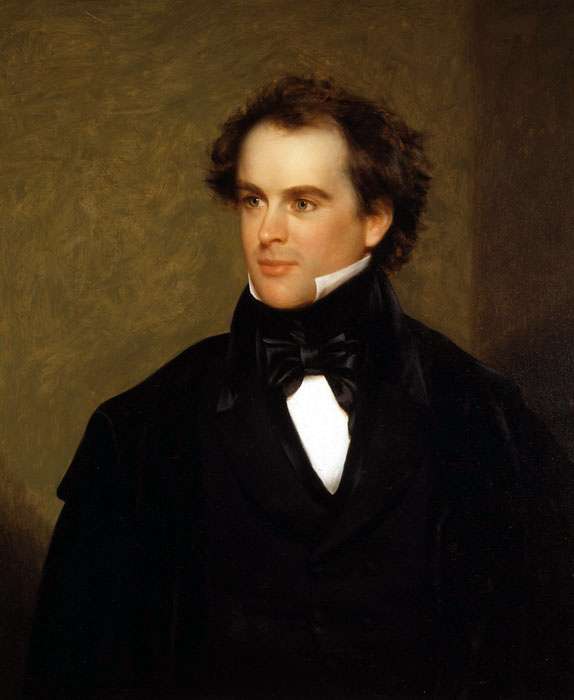In 1832, a young widower named Horace Mann moved into a Boston boardinghouse where he met two intellectual schoolteachers from Salem, Mary and Elizabeth Peabody. They were sisters.
Mary fell in love with Horace Mann at first sight. But Mary soon left for Cuba with a third sister, Sophia, to work as a governess for a few years. Elizabeth became Mann’s new best friend. She wrote frequently to Mary that the despondent Mann had held her hand and given her brotherly hugs. Mary was not pleased.
Elizabeth protested she only wanted to be Horace Mann’s friend. She may have protested too much. In one letter, she told Mary he’d signed a note to her, “Yours very affectionately,” and she confessed she “actually kissed those sweet words.”
Ten years later, Mary Peabody married Horace Mann, who became a celebrated education reformer, member of Congress and president of Antioch College.

Horace Mann
Twice Bitten, Never Shy
By all accounts, Mary was prettier than Elizabeth. Megan Marshall, in The Peabody Sisters, describes Elizabeth as “not unattractive, shiny-haired, slim and small – a woman who talked easily and could coax a shy man to speak freely as well. She was also messy, headlong and headstrong.”
Of the three accomplished Peabody sisters, Elizabeth would achieve the most.
Except in love.
In 1837, Elizabeth Peabody, at 33, had moved back to Salem with her family. She befriended a handsome young neighbor named Nathaniel Hawthorne. He had spent most of the last 12 years writing in the upstairs bedroom of his family’s house.
Elizabeth loved his Twice-Told Tales, and promoted his work to Mann. She also wrote a glowing magazine review and even sent the book to her correspondent, English poet William Wordsworth. Hawthorne’s work got some positive reviews, and he emerged from his seclusion.
Hawthorne courted Elizabeth– “flamboyantly,” according to Susan Cheever in American Bloomsbury. He also courted a woman named Mary Silsbee. Elizabeth helped get Hawthorne a job he needed desperately in the Salem Customs House. Then Hawthorne threw over Mary Silsbee and the rumor flew around Salem that he would marry Elizabeth.
Elizabeth later wrote, “Had Hawthorne wanted to marry me he would probably not have found much difficulty in getting my consent.”
Instead, Hawthorne fell in love with Elizabeth’s pretty younger sister, Sophia, also living at home in Salem. Sophia was an artist and an invalid, no doubt because of the mercury and opium with which doctors treated her. Hawthorne and Sophia married five years after they first met, on July 9, 1842.

Nathaniel Hawthorne, 1841, by Charles Osgood
13 West Street
Elizabeth Peabody never married. She opened a bookstore and lending library at 13 West St. in Boston.
There she published periodicals, novels, children’s books, sermons and essays, including Henry David Thoreau’s Civil Disobedience and the Transcendentalist journal The Dial. Her bookshop frequently hosted authors such as Ralph Waldo Emerson, Margaret Fuller, Bronson Alcott and Oliver Wendell Holmes. She opened the first kindergarten in the United States with her sister Mary and later crusaded to open them across the United States. She became an advocate for the Paiute Indians and helped them open a bilingual school.
Elizabeth Peabody died at 89 on Jan. 3, 1884, having outlived her sisters, their husbands and her Transcendentalist friends. She is buried in Sleepy Hollow Cemetery in Concord, Mass.
This story about Elizabeth Peabody last updated in 2023. Image of Horace Mann By Montanabw – Own work, CC BY-SA 4.0, https://commons.wikimedia.org/w/index.php?curid=83792751




15 comments
Maybe that’s where the old saying….always a bridesmaid, never a bride….originated. You think??
Maybe she outlived them all because she stayed single!
Maybe she outlived them all because she stayed single!
Jonathan Winters?
Jonathan Winters?
I was thinking the same thing! LOL!
Well, I guess we’re all about the same age! The first thought that came to my mind was Jonathan Winters!! LOL
[…] disgrace to genius and learning.’ She tried to persuade Ralph Waldo Emerson, who she met through Elizabeth Peabody. Emerson introduced her to a wealthy friend who paid for her to spend a year in England researching […]
[…] 1809 in Salem, Mass. , the third of the three extraordinary Peabody sisters. Her oldest sister, Elizabeth Palmer, became a member of the Transcendentalist circle, publishing their work and hosting their talks at […]
[…] settlement house, now a community center in Somerville, was named after Elizabeth Peabody, a central figure in the Transcendentalist movement. She was an educator and the sister-in-law of […]
[…] Horace Mann, a Franklin native and the father of American public education, was enthralled by several books he found in the library. […]
[…] Tales brought him out of his bedroom and into the light. The Hawthornes’ neighbor Elizabeth Peabody discovered the stories were written by the younger brother of her childhood friend – Elizabeth […]
[…] and one of the famed Peabody sisters of Salem, Mass. Her older sister — and often collaborator — Elizabeth Peabody worked as an educator, bookstore owner and business manager of the Transcendentalist magazine The […]
[…] and servants to support the family, May worked as a teacher at the first Kindergarten founded by Elizabeth Palmer Peabody for a month; later she taught art at the Concord school run by her father's friend Franklin […]
[…] had “Peabody” as her middle name after Bronson Alcott’s friend and teaching assistant, Elizabeth Peabody. Three years later that changed to her grandmother’s maiden name after Bronson and Peabody had a […]
Comments are closed.